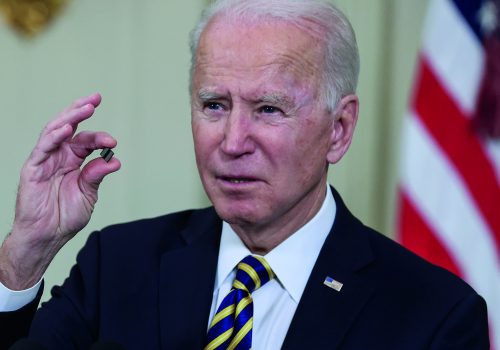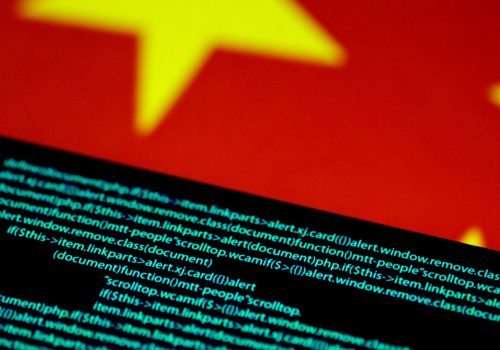The Biden administration has put forward plans to require certain US persons to notify the US government in advance of making certain types of investment in People’s Republic of China (PRC) entities. In particular, the United States is interested in entities engaged in activities related to “covered national security technology or products.” The White House released a long-anticipated Executive Order on August 9 that directs the Treasury Department, in consultation with the Commerce Department, to develop a new regulatory system for these notifications. This may at first sound narrow and procedural, but it has important implications for US national security and US-China trade.
In addition, the new regulations will prohibit US persons from engaging in certain investment transactions with covered foreign parties. The order gives the Treasury Department the authority to, in conjunction with the interagency, identify the types of transactions and technologies that may pose a risk to US national security and thereby warrant notification or prohibition. At the same time, the Treasury Department issued an Advanced Notice of Proposed Rulemaking (ANPRM) outlining questions under consideration for the development of such rules, and it has provided the public forty-five days to comment.
The order’s release comes after a long and sometimes confusing policy discussion among the foreign policy community, the White House, Capitol Hill, and partners and allies. The main point of contention was on whether the United States needed new authorities over outbound investment activities to protect national security and, if so, what those authorities should look like. The new executive order is the Biden administration’s move to settle this debate. Below is a brief and accessible overview of the order, the impending regulations, and potential implementation challenges.
Why is the administration doing this?
The order makes clear that the intent of an outbound investment regulation is to address narrow national security threats posed to the United States by countries of concern (here defined as China and its territories of Hong Kong and Macau) that “seek to develop and exploit sensitive or advanced technologies and products critical for military, intelligence, surveillance, or cyber-enabled capabilities.” The regulations, as envisioned, will capture only a small percentage of US investment in China.
Crucially, the order will not cover passive investment, nor will it cover investments related to critical supply chains or technologies related to biotechnology or the green energy transition. Thus, the order represents a more limited focus than the National Critical Capabilities Defense Act (NCCDA), which was proposed by Senator Bob Casey and Senator John Cornyn in the summer of 2022. It also covers a smaller set of investment activities and technologies than does the Outbound Investment Transparency Act (OITA), which Casey and Cornyn drafted as an attenuated revision to the NCCDA and which they successfully attached to the Senate’s version of the National Defense Authorization Act (NDAA) for fiscal year 2024. At this time, it is unclear whether the OITA will be included in the conferenced version of the NDAA or whether or how the OITA and the administration’s order will be harmonized.
The narrow focus of the order on non-passive investment in a small set of critical technologies with clear military application is consistent with the administration’s insistence that its goals are national security focused and are not designed to address supply chain security, human rights, or broader economic competition concerns. Nor are they designed to inflict economic harm on the Chinese economy.
What kinds of transactions are covered?
The order directs the development of regulations that will define a set of ”prohibited transactions” and “notifiable transactions” for “US persons.” The definition applies both to persons in the United States and to US individuals and entities abroad. In other words, a foreign subsidiary of a US company will need to comply with these regulations, as will any subsidiary of a foreign company that is incorporated in the United States.
The regulations will cover a broad range of non-passive investment activities including mergers and acquisitions, venture capital and private equity, convertible debt financing, greenfield investment, and joint ventures. The regulations will not cover most passive investments such as investments in publicly traded securities or investments made by limited partners below a yet-to-be-determined threshold.
These non-passive investments, whether direct or indirect, will be prohibited to “covered foreign persons” (more on that in a bit) when they engage in activities related to certain equipment and technology needed to develop, design, or produce advanced semiconductors, the installation or sale of supercomputers, or a range of quantum computing technologies. Persons engaging in these non-passive investments will be required to notify the US government before investing in “covered foreign persons” that engage in activities related to semiconductors and microelectronics that are not prohibited (and likely considered more mature technologies) and also artificial intelligence (AI) systems that are designed for military or intelligence end-uses that pose a national security risk.
What is a “covered foreign person”?
The intent of the regulations is to cover entities that are organized under the laws of the PRC, have a principal place of business in the PRC, including its territories of Hong Kong and Macau, or are majority-owned by PRC individuals or entities, including PRC subsidiaries in third countries.
What questions remain?
The ANPRM that was prescribed by the order and simultaneously released indicates that the Treasury-led interagency is thinking carefully about how to design a notification and prohibition rule that is binding enough to hook transactions relevant to national security but is not overly restrictive. This task is proving difficult, and the ANPRM asks for feedback around several key unresolved questions. Here are three:
- Will the regulations impose prohibitions on covered investments in a set of AI activities? While advanced semiconductors and quantum information technologies are relatively easy to define on observable, technical metrics, AI is a much more amorphous category. Treasury has requested comments to help it consider whether it is possible or advisable to create a prohibition category for a subset of AI software designed for national security-relevant end uses such as military surveillance.
- Will the regulations be able to effectively close potential loopholes to coverage, or will the regulations incentivize firms and investors to restructure the way they organize their businesses and capital to avoid prohibition or notification requirements? Some have pointed out that proposed definitions of covered foreign persons in the ANPRM could end up exempting major Chinese tech conglomerates if they put all activities related to covered technologies in subsidiaries. However, the ANPRM also indicates the rules will apply to both direct and indirect investments precisely in order to prevent US persons from “knowingly directing transactions” that would otherwise be prohibited, suggesting that the Treasury may interpret their proposed rules as closing such a loophole. Confusion over what is and what is not covered could reduce effectiveness and increase unintended consequences if it is unclear how to comply with the regulations and if complicated indirect investing schemes could make regulatory evasion more possible.
- How will US allies and partners respond? The effectiveness of these regulations on slowing down Chinese indigenous development of critical technologies will depend on whether key allies and partners develop similar regulations. To its credit, the Biden administration has spent substantial time working to find common ground. The order was released only after a Group of Seven communique on economic resilience and economic security recognized that outbound regulations may be appropriate in narrow cases and after the European Security Strategy announced the European Commission’s plan to table an outbound proposal by year’s end. Still, the length of time it has taken for the United States to release its order, and the complicated questions of implementation that remain, suggest that it may be awhile before allies promulgate their own outbound rules.
Beijing responded to the order this week by claiming the United States was “using the cover of ‘risk reduction’ to carry out ‘decoupling and chain-breaking.’” That is, to say the least, an overstatement of the targeted scope of this order and its likely regulations. It also elides the fact that the PRC has long implemented its own inward and outbound investment restrictions. But it will be important to watch how these regulations are further defined and implemented, as well as what might follow them.
Sarah Bauerle Danzman is a nonresident senior fellow with the GeoEconomics Center’s Economic Statecraft Initiative and an associate professor of international studies at Indiana University, Bloomington.
Emily Weinstein is a nonresident fellow with the Atlantic Council’s Global China Hub and a research fellow at the Center for Security and Emerging Technology.
Further reading
Wed, Sep 14, 2022
Sand in the silicon: Designing an outbound investment controls mechanism
Issue Brief By
The stakes for rethinking the investment relationship between the United States and China are high. An outbound investment mechanism must be narrowly targeted, clearly defined, non-duplicative of existing tools, scoped proportionately to administrative capacity, and paired with meaningful multilateral engagement with allies and partners.
Thu, Feb 23, 2023
United States–China semiconductor standoff: A supply chain under stress
Issue Brief By Jeremy Mark, Dexter Tiff Roberts
What are the implications of US semiconductor policy for global semiconductor supply chains and the competition for primacy in an industry critical to the economy and global security?
Tue, Jun 27, 2023
Global Strategy 2023: Winning the tech race with China
Atlantic Council Strategy Paper Series By Peter Engelke, Emily Weinstein
The United States and the People’s Republic of China (PRC) are engaged in a strategic competition surrounding the development of key technologies. Both countries seek to out-compete the other to achieve first-mover advantage in breakthrough technologies, and to be the best country in terms of the commercial scaling of emerging and existing technologies.
Image: Flag of China displayed on a phone screen and microchip and are seen in this illustration photo taken in Krakow, Poland on July 19, 2023.



